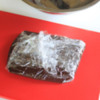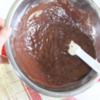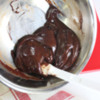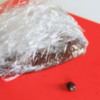
Recently I've heard some trepidation about modeling chocolate expressed within my circles on the internet. But, truly, there's nothing to fear about this quick and easy two-ingredient recipe. Plus, it's really tasty, much tastier than rolled fondant, especially if you use a high quality chocolate. Doubtful? Come along with me; in just a few minutes, you'll be a believer!
Yield: About 10 ounces dough
Prep Talk: After the dough is mixed, it needs to sit, wrapped and contained, in a cool (60⁰F to 65⁰F) but unrefrigerated place to solidify to a pliable, un-sticky working consistency. Setting time can range from one to a few days or more depending on ambient conditions. (The hotter it is, the longer the dough will take to set.) When not in use, the dough should be wrapped tightly in plastic and then sealed in an airtight container; otherwise, it can quickly dry out.
Ingredients:
- 7 ounces premium semisweet (about 55% to 60% cacao) chocolate
- 1/3 cup (about 3.5 ounces) light corn syrup
Method:
1 | Weighing is always a good thing when baking, and the same is true in this case. Too much or little chocolate in this recipe can alter the end consistency. Weigh your chocolate in the bowl that you'll be melting it in, taking care to "zero out" the weight of the bowl before you add the chocolate (third photo, in the attachments below). The bowl should fit your double boiler (or sit nicely atop a water-filled saucepan). Break the chocolate into small pieces and place the bowl over barely simmering water on low heat. Stir occasionally until the chocolate is completely melted. Do not over-heat the chocolate, or it can scorch and seize.
2 | Remove the chocolate from the heat and add the corn syrup (fifth photo). Stir just until the mixture turns into a thick, smooth paste that cleans the sides of the bowl, generally no longer than a minute or so. The mixture will at first look a bit grainy or streaky (sixth photo), but after enough stirring, I promise you it will come together into a smooth (somewhat sloppy) mass.
If working with white chocolate (recipe soon to follow), it's very important not to over-stir the mixture or it can break and exude a lot of cocoa butter (much more than it normally does), which then leads to a grainy end product. But, no worries with semisweet chocolate; it is much less prone to breaking. I've stirred this mixture for 2 to 3 minutes, maybe more, and I've had no trouble with it whatsoever.
3 | Cover the bowl with plastic wrap and allow the dough to cool a bit until it is less sloppy and more easily handled. I usually allow a cooling off period of about 20 to 30 minutes, depending on the room temperature. Turn the dough onto a very smooth, flat piece of plastic wrap, taking care to keep pleats of plastic from getting in the dough. The plastic will only be hard to remove later once the dough solidifies around it.
At this stage, the dough will still be very floppy - kind of a soft, sludgy consistency. You should be able to shape it into a ball without it sticking to your fingers (see eighth photo), but the ball will be very squishy and pliable. I know, it's hard to see what I'm describing in the picture, so you'll have to trust me! Wrap the dough disk a few times in plastic wrap. Even wrapped, the mass will still be quite floppy (see ninth photo), but, again, no worries. There's nothing like a little setting time to firm it right up. Store the dough, as directed above, in an airtight container, ideally dated so you remember when you made it.
4 | Allow the dough to sit at room temperature, all packaged up, for 24 hours or more. Again, depending on the storage temperature, the dough can take as little as overnight to set into a solid working consistency, or as long as a few days to a week. The last photo shows my dough after 24 hours. In this case, the dough was stored in a fairly chilly room at the end of May, so it set up to a manageable working consistency pretty darn fast (see how rigid it is).
The dough will last a very long time if stored as described above. But as it sits, it continues to harden. What this means is that, as time wears on, you may need to spend more time kneading the dough to a pliable working consistency before you can start shaping it into anything else.
And that's all she wrote! Was I right, or what? Pretty darn simple!
Stay tuned for my white chocolate variation; it's a little more tricky, but certainly nothing that should cause you to break into a sweat. I'll also have dough-shaping tutorials and videos coming sometime in June or July of this year.











Comments (20)